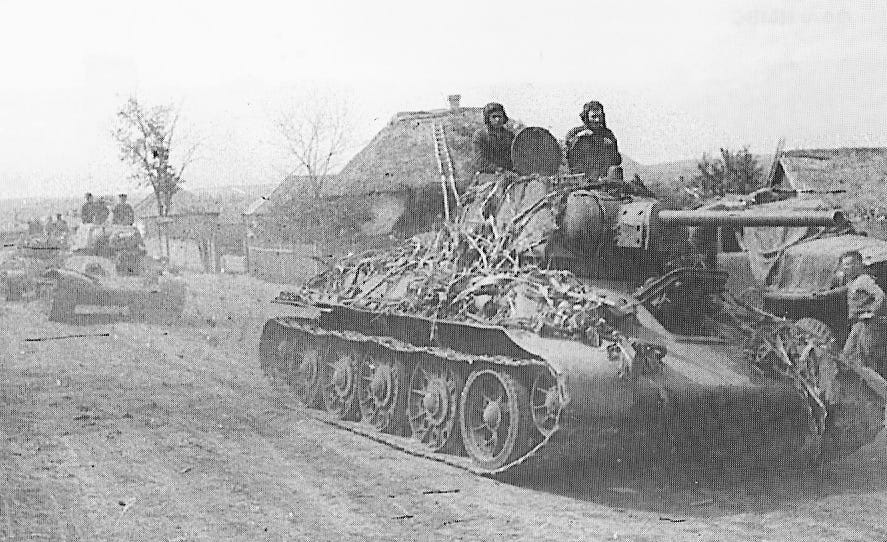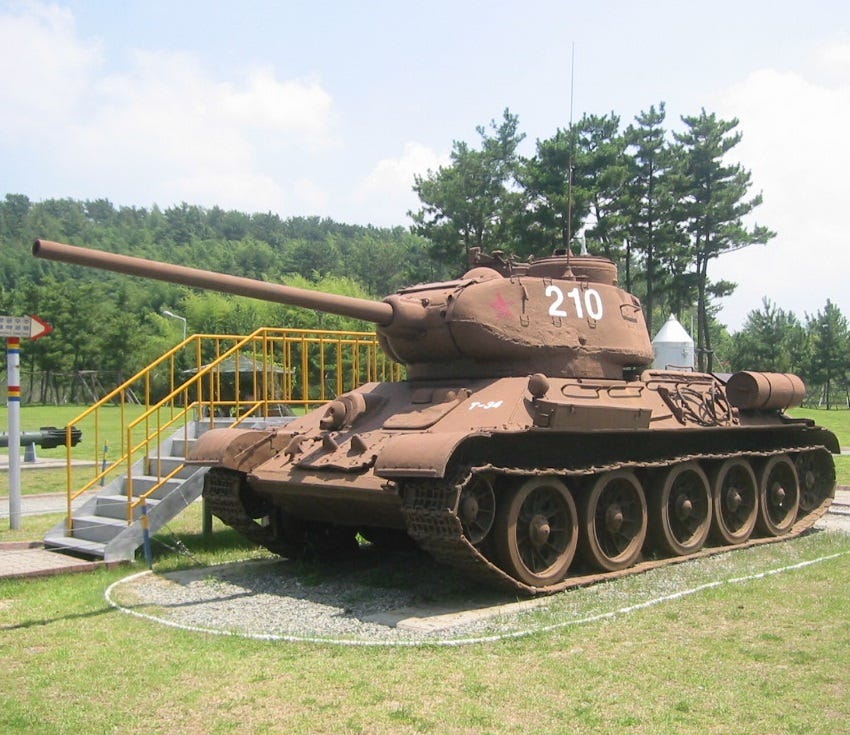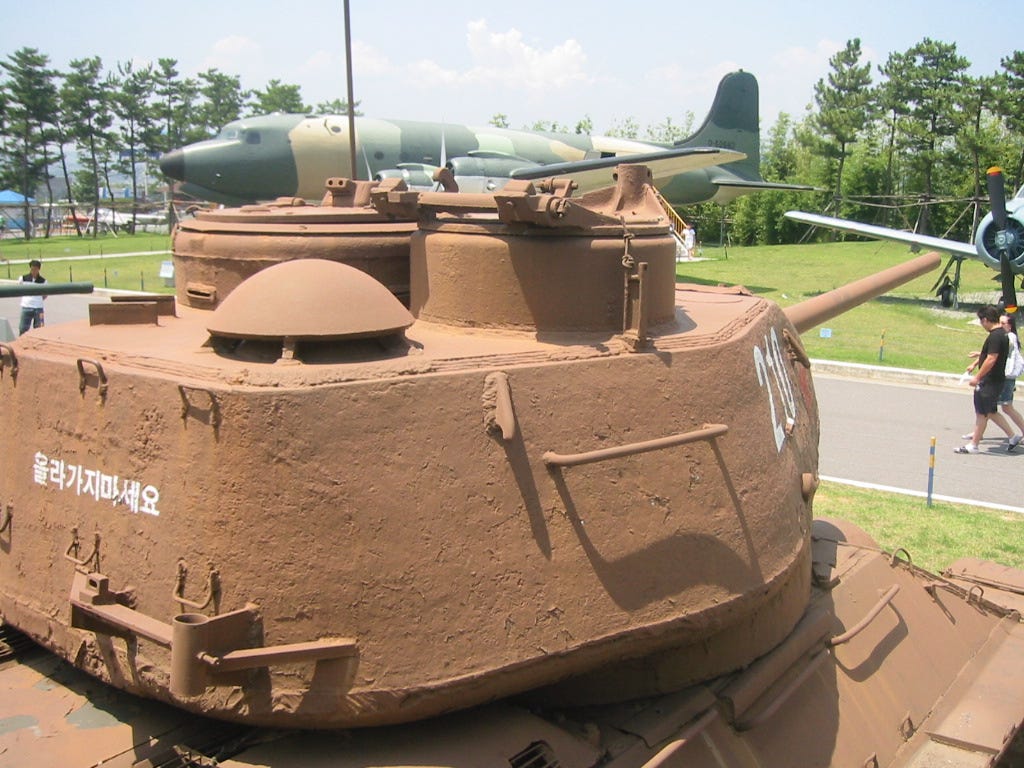Ride Into History-Machines: T-34/85 Tank Part 1
Winning the War in the East
The German tank crews started the engines of their Panzer II, II and IV tanks early on the morning of June 22nd, and behind a shield of artillery fire, supported by Ju-87 dive bombers, they advanced into Soviet-held territory aiming for Moscow, far to the east. Operation Barbarossa, the all-out invasion of the Soviet Union, was underway, and at the very tip of the spear were the German panzers, fanning out in the wide-open grassy spaces of the Soviet Union. It was out there, on the grassy steppes, that the German tankers were to encounter a vehicle that struck fear into their hearts.
Introduced in 1940, the design of the T-34 borrowed from that of earlier tanks and was also informed by the experience of Soviet armor in the far east in the late 1930s, in an undeclared war of large-scale border clashes with Japanese forces. In 1940, the poor performance of Soviet tanks in the Winter War in Finland, and the good showing of modern German armor in France also spurred the production of the new tank. While there were teething difficulties, the tank started rolling off the production lines in numbers and equipping front line units in early 1941.
The early T-34/76 had several features setting it apart from other tanks of its era, including sloping armor. The tanks of the time were particularly heavy, largely due to their thick steel plating, used to protect the vehicle from the shots of other tanks and from things like aircraft cannon and anti-tank gun rounds. Thick, heat-treated steel plates were used, and in German tanks like the Panzer IV and the Tiger, the frontal armor plates were flat, rising vertically from the hull. If, for example, those plates were ten centimeters (four inches) thick, that’s all the distance an anti-tank round would have to penetrate, it would only need to go straight through the thickness of the plate. However, if the plate was to be sloped, built at an angle, the distance that a round needs to travel through the armor to penetrate has been effectively increased. Sloped armor is also much more likely to cause an impacting round to deflect off of it. The round is striking at an angle and will tend to ricochet, to bounce, rather than to dig into a vertical wall of steel.
The T-34/76 also had comparatively wide tracks, a huge advantage in spring and autumn, when Soviet terrain became a muddy quagmire due to melting snow and rain. The wider tracks distributed the tank’s weight on the terrain evenly, allowing it to traverse swamps and bogs, places where German tanks with their narrower tracks would be stuck, their relatively thin tracks digging useless trenches in the muck. The vehicle’s suspension, copied from an American designer, J. Walter Christie, was excellent. American Christie designed tanks had been sold to the Soviets almost unwittingly, in one of those brilliant intelligence coups that the pre-war Soviet spy agencies were so good at, like the recruitment of future agents at England’s Cambridge university in the 1930s. Combined with a fairly reliable and sufficiently powerful diesel engine, the T-34 was excellent at traversing offroad terrain.

The original vehicle also had a seventy-six-millimeter gun, a size of gun that many tanks of the time had. The Panzer IV and American M4 Sherman tanks had seventy-five-millimeter guns, which along with the original gun of the T34/76, were becoming inadequate by 1944, but were still effective earlier in the war. The T-34’s main gun could easily handle the armor of the Panzer II, III and IV and would be more than adequate for the first couple of years of the German invasion.
Things were not all good, however, as early in the war there was a terrible leadership vacuum in the red army, largely due to the actions of Stalin himself. During the mid to late 1930s, Joseph Stalin had been intent on wiping out any domestic opposition, real or imagined, purging Soviet society while conducting show trials and executions, presided over by Nikolai Yezhov, the diminutive head of the NKVD, the Soviet intelligence-security agency. The purges had taken a serious toll on the red army’s officer corps, and as a result, after the invasion, many had to be rehabilitated, released from political prison camps to return to the army to combat the invading Germans, while some were simply missing, victims of Stalin and his underlings. During the pre-war years, German intelligence had even helped to weaken the Soviet armed forces, by fabricating, and leaking to the Soviets, documents implicating Soviet officers in intelligence plots against the Soviet state. Thus, competent military leadership was often lacking in the early years of the war for obvious reasons, as the Red Army rebuilt itself and learned from the hard lessons of war on the eastern front. The upshot was that even superior Soviet weapons like the T-34/76, regarded by some knowledgeable German observers as the best tank in the world at the time, were poorly used in the early stages of the German invasion due to a crippling leadership vacuum.
The T-34 often lacked a radio, a piece of equipment in short supply in the Soviet Union, and tank actions could be uncoordinated as a result. Command tanks would have radios, but others within a formation would have to rely on flag signals. Even with greater access to radios, they would often be one-way, only allowing subordinates to receive orders. Here, the shortcomings of the Soviet system, the Stalinist demand that orders be unquestioningly obeyed under threat of torture, imprisonment or death, can be seen in the way such top-down methods of command in the Red Army hindered Soviet military operations at the tactical level. Tank commanders, unable to broadcast, could not effectively communicate the information necessary to exploit momentary German vulnerabilities on the battlefield.
But. But! The T-34 was there. In the snow outside of Moscow in late 1941, in the darkest days of the war, the T-34 was there. During the German summer offensives of 1942, the T-34 was there. Down in the Caucasus, as the Germans drove deep to the southeast, the T-34 was there. Early in the war, entire factories had been moved to the east of the Ural Mountains, a war winning strategy on the Soviet’s part. T-34 production was necessarily halted, as production facilities were loaded onto rolling stock and moved out of range of German bombers. At that time, the Volga Tractor Factory, more accurately the Dzerzhinsky Tractor Factory, named after “Iron” Felix Dzerzhinsky, Nikolai Yezhov’s predecessor, took up the slack in T-34 production in a city on the Volga River named after the Soviet leader.
There, in Stalingrad, during the battle that became the turning point of the Second World War in Europe, the T-34 was there. The Germans bombed the city into rubble and then drove eastward through heavy urban combat to the river, leaving isolated pockets of Soviet resistance on the western bank of the Volga River, one of them the all-important tractor factory, which continued to produce T-34s till the last, when the facility itself became an urban fortress, parts of it changing hands repeatedly in vicious fighting. There remain tales, perhaps apocryphal, of completed T-34 tanks being driven directly out of the factory, still unpainted, to battle the Germans in the streets of the city surrounding the production facility.
Then, when the Soviets struck and encircled both the German Sixth Army and the Fourth Panzer Army, a quarter of a million men and their equipment, it was the T-34 that spearheaded the pincer arms that closed around Stalingrad in early 1943. When Von Manstein’s panzers attempted to break through to the troops trapped in the pile of rubble that was the city, it was the T-34 that turned them back and maintained the ring of steel around the besieged Germans. When Der Kessel, the pocket of trapped German troops, shrank, the T-34 was there, helping to tighten the noose.
Later in 1943, as the Germans attempted to cut off the westward bulge on the Soviet lines in the Kursk salient, the T-34 was there, as units like the Fifth Guards Tank Army advanced westwards through the dust and heat to battle. It would be the T-34 facing the German panzers at Pokhorovka, in one of the largest tank battles in history, and yet at Kursk, more often than not it was to be mines and effective anti-tank gun fire that would cripple the German machines.
Late in 1943, the seventy-six-millimeter gun on the T-34/76 was having difficulty in penetrating the armor of new German tanks like the Tiger, and the cramped turret of the T-34/76 was hindering the tank’s fighting ability. The early tank had a crew of four, a front gunner/replacement drive, a driver, a main gun loader and the commander/gunner. The issue here was that the tank’s turret was quite small and lacked room for a third person within it. The commander could stand with his torso out of the top hatch, but he was blocked by the forward opening hatches and could not wind his seat up to comfortably sit with his torso out of the hatch. He had to fight with limited visibility and command the vehicle while being responsible for firing the main gun.
It’s interesting to note that while the T-34/76 turret was small, Soviet tanks would continue to be cramped inside in the decades to come, as they sought ever lower frontal profiles in later designs, making for a smaller target. Throughout the cold war, as Soviet males were inducted into the army, all of the men on the shorter end of the scale, guys less than about 170 cm tall (5’ 7” or so), would be automatically assigned to tank crews, as they could fit into the vehicles much more readily than a taller man.
An entirely new tank, the T-43, was proposed, to address the shortcomings of the T-34/76 and prototypes were manufactured, but retooling T-34 production lines was going to be time consuming and difficult. In the end, the T-43’s turret was basically installed on the T-34 chassis and hull, and the T-34/85 was born in early 1944.
The larger turret featured an eighty-five-millimeter gun, one that could penetrate the armor of a Panther or Tiger tank, and provided more room for the crew, which now numbered five, with the addition of a gunner for the main armament. The turret also featured new hatches. Now the tank commander could spend the majority of his or her time unbuttoned, that is, with his or her torso exposed out of the commander’s top hatch so a comprehensive impression of the battlefield could be obtained. Basically, so that things could be seen clearly as during battle, the commander would be buttoned up, with hatches closed, and would have to rely on a periscope and vision slits for situational awareness. The new tank also featured a radio in the turret, unlike older models with the radio in the hull, so that the tank commander was now free to command the vehicle, unhindered by the need to fire the main gun and able to communicate effectively.
The T-34/85 was a war winning vehicle. While the German Panther, a tank designed as an answer to the T-34, may have been engineered to more exacting specifications in a fussily precise German manner, along with the Tiger I and Tiger II tanks, that wasn’t necessarily a good thing. The Soviets deliberately produced to a lower standard, concentrating on quantity over quality, enjoying a massive superiority in tank numbers as a result. During the Second World War on the eastern front, a tank’s lifespan could be measured in months, and perfection was not required of a vehicle likely to be destroyed by enemy fire within one hundred days of being deployed. In tanks like the T-34/85, and the T-55 to follow in the post war years, the diesel engine was often machined roughly enough to produce kilos of iron filings in the oil sump, as engine components were broken in and rubbed themselves smooth while the engine was run with plenty of oil. It’s interesting to note that the original V-2 engine originally employed in the T-34 survives to this day, albeit in heavily upgraded form, powering modern Russian tanks such as the T-90.
Tanks like the T-34, when confronted by well-trained or experienced soldiers with appropriate equipment, are vulnerable, especially if the crew are buttoned up inside. For this reason, the T-34 often carried tank riders, soldiers who rode on the outside of the vehicle. When their tank was confronted by enemy infantry, the tank riders would dismount and meet the threat posed by the opposing soldiers head on, allowing the Soviet tank crews to worry about other tanks, anti-tank guns and mines, secure in the knowledge that their vulnerable flanks and rear were covered by their own organic infantry. Organic here meaning soldiers immediately available from within their own military formation. Like the T-34, the tank riders had an average life expectancy of around 90 days, but as one of them once said, they did not have to walk. Still, war is filled with anomalies, and I am sure there were T-34s that survived longer than three months and drove all the way from the outskirts to Moscow to Berlin, just as there are tales of surviving soldiers who walked the entire distance, perhaps riding on a T-34 for part of the distance.
The T-34 was to continue to fight throughout 1944, while driving to the west, and as the Soviet Generals Zhukov and Konev raced to be the first to enter the enemy capital of Berlin, the T-34 was to face the last-ditch resistance of the Germans on the Seelow Heights, the final major natural obstacle before the city. T-34s would roll through the streets of Berlin as the Soviet flag was raised over the Reichstag, before meeting the M4 Sherman tank on the Elbe River in friendship, as the allies linked up victoriously in Germany.
The two vehicles, victors of the war in Europe, were to meet again soon thereafter, but this time it would not be as allies on the Elbe River. The two vehicles, the T-34/85 and the Sherman, in the form of the M4E3E8 “Easy Eight,” were to meet as adversaries in the rugged terrain of the Korean peninsula, which is where we will rejoin them in the second part of this series looking at what can be considered one of history’s greatest military vehicles.
In the Ride Into History project, I am on my bicycle (sometimes) and examining the Korean War and the history of Korea in the decades thereafter and therebefore, from explorations of the legacy of the war in modern Korea to deep dives into the past. So why not come along for the ride? Subscribe to receive regular email newsletters in your inbox, as well as offerings such as photographic, audio, and video content.




